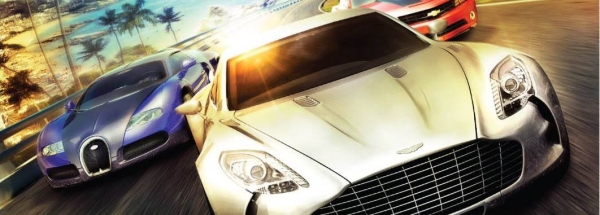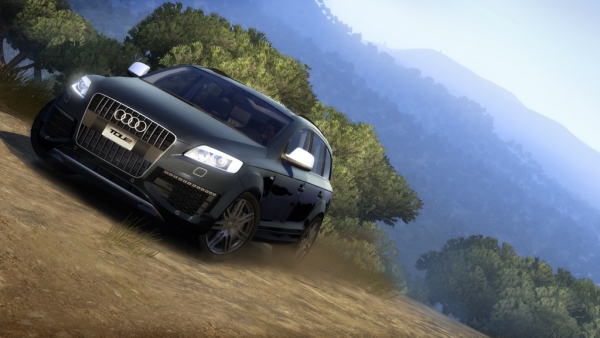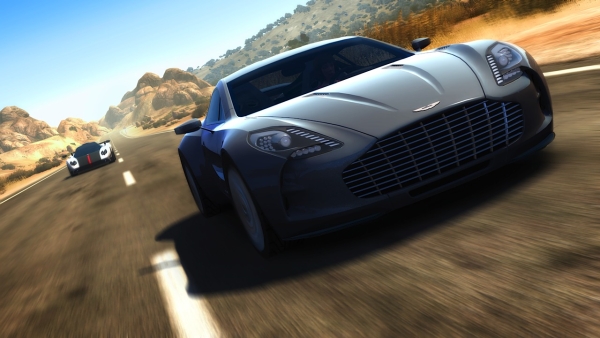
The original Test Drive Unlimited was a legitimate sleeper hit in the earliest days of the Xbox 360. Thanks to its combination of classic arcade-style racing, the stylish open world map of Oahu, and the introduction of Massively Open Online Racing (better known as M.O.O.R.), TDU garnered a loyal following. However, that was over four years ago, and for a while it seemed the Unlimited series would be a one-and-done. Thankfully, last year, Atari and Eden Games satisfied the demands of the followers by announcing Test Drive Unlimited 2… and now it’s here. Was it worth the wait?
Platform: PC, PS3, Xbox 360 (Version Played)
Publisher: Atari
Developer: Eden Games
Genre: Vehicular Jersey Shore
Release Date: February 8, 2011
ESRB Rating: Teen
Test Drive Unlimited 2 places you on the Spanish island of Ibiza, where you’re currently employed as a lowly valet. Your employment status changes almost immediately, however, as you gain the attention of “Solar Crown.” Solar Crown is basically a racing reality show – except instead of professional drivers, your opponents can best be described as rich, trust-fund trash in their daddy’s finest vehicles. In fact, the entire thing has to be a subtle satire of trashy reality shows… there’s no way this stuff is meant to be taken seriously. Not with these ridiculous lines and pathetic voice acting. In fact, let’s never mention it again. Instead, think of TDU2 as a “racing vacation” where it’s just as fun to cruise around the exotic locales as it is to partake in a traditional race. While Ibiza is the new hotness, the old standby of Oahu is really where most of the action takes place. After reaching a specific point in the game, you’re given access and can hop between islands by simply heading to the airport.
Like the original game, TDU2 features the M.O.O.R. system, which effectively makes the game a racing MMO. As soon as you complete the tutorial and get on the roads, other drivers will join you for instant challenges, online events, and user-created community challenges. For those not interested in any of this, don’t fret – like TDU, the sequel allows for the disabling of all online interactions. Even without the online portion of the game, TDU2 features a very meaty single player campaign with over a hundred events to find and participate in. Test Drive Unlimited 2 isn’t all about racing, though – the “lifestyle” simulation from the last TDU is also fully fleshed out. Buy clothes for your avatar, head to the doctor for some hardcore plastic surgery (complete with being able to race in bandages for a while!), and buy homes to store your cars. I even saw a yacht for sale. It’s all a bit hokey, but at least buying homes equals more space for vehicles.
One of the things that Test Drive Unlimited lacked was a day/night cycle, which left Oahu in a perpetual state of daylight. TDU2 rectifies this by implementing a very nice cycle that even adds in weather conditions – conditions that can adversely affect driving. Most of us are well aware that it’s way more difficult to brake and corner in real-life; the same applies here. Stopping on a dime at 200mph? Yeah, not happening. Driving in the rain fundamentally changes how the game is played. Driving at night also flips the script – when you’re out in the middle of nowhere with only headlights to guide the way, blind turns can be quite tricky.

As is the case with almost every open-world game, TDU2 offers plenty of rewards just for exploring the islands. In fact, you’re almost required to, as finding new car dealerships, upgrade shops, car washes, side missions, and real estate offices can only be done by exploring the map. You can’t even get to various race events just from selecting the map screen, you’re forced to physically drive to them, though you could just instantly warp to a nearby area to cut the excess driving time. While unlocking new stuff is an obvious perk of exploration, TDU2 offers two other ways to encourage taking the long way to events. After playing for a bit, you unlock a “metal detector” that can be used to find wrecked cars. When you’re out cruising (as in not actually racing), the detector will start acting up and if you follow the beeps, it’ll lead you to the wreck. Acquire all of them in a specific section of the map, and a unique car becomes available. After a while, you’ll also get a call from a photographer asking you to snap pictures of landmarks. Finding them is one thing, but many of the pictures have some maddening requirements. Some require a specific time of day, set weather, and even a particular car. At least you can add bookmarks to the map to revisit these later.
While engaging in race events is the obvious draw, the side-quests that present themselves can be quite fun and a path to easy money. Some of these missions ask you to deliver a car to a repair shop, others ask you to drive someone to a destination in a speedy fashion. A few ask you to drive like a complete idiot for their own amusement, others demand you tail another car to discover what they’re up to. Yes, the groaning was quite loud when these missions made their first appearance. There’s a hundred of these in total, and unlike regular races, these actually have a small time limit – if you don’t reach a mission fast enough, they disappear for a while. It’s pretty dumb, yes, but it does mean that your map will never be drowned in these things.
In a puzzling design choice, Test Drive Unlimited 2 requires players to earn licenses to unlock the core racing events. The tests are rarely challenging unless you’re matched with a difficult vehicle, but they’re still a chore to finish just to unlock other race classes. In TDU2’s case, there are three different classes – classics, off-road vehicles, and traditional “asphalt” cars. Unfortunately, motorcycles are nowhere to be seen in TDU2 despite being an integral part of the original game. The off-road races are the replacement, which does bring one thing to the table – more roads to traverse. Alas, the off-road events are either dull races through narrow spaces, or obnoxious events with tons of dips, blind corners, and tricky curves that put you into a broken wall. More often than not, a single mistake (that you might not even see coming) means having to restart. There’s no reason why a rewind function was omitted from the game – it’s an arcade racer, not Gran Turismo.

On regular roads, the racing action is much better – with a caveat. In general, most cars are responsive and easy to drive, making for an enjoyable driving experience. Then… you find one of the bad ones. These cars seem to be riding on ice at all times, thanks to their oversensitive steering, touchy acceleration habits, and lack of solid cornering action. Despite three different settings for driving assists and various options for adjusting sensitivity, it’s almost impossible to get these beasts to cooperate. Even worse, in rainy conditions they become… gah, let’s not even talk about it. It severely limits the vehicle selection, as most people will avoid the rotten ones and stick to cars that mere mortals can control. The odd irony is despite the off-road stuff being pretty lame, its selection of cars has no weak spot. They all handle quite well whether you’re on dirt or on asphalt.
It’s almost like they planned for this, however, as in general the single player stuff is quite easy. Fans of the original game will recognize that this was an issue there too. A few races might give you some trouble (usually because you hit a wall, slid off into the grass or just lost control), but for the most part you can win races with seconds to spare regardless of your vehicle, though choosing a weaker car could result in a situation where perfection is required. The only real challenges might be the speed trap events that track your speed, but as long as you get the exact pattern to hit the cameras it too becomes a simple affair. It tends to make many of the events a boring inevitability. Where the bad handling cars hurt the most is online, when racing others who don’t have TDU2’s poor AI quirks. They don’t slow to a crawl to make a turn or plow into traffic like their cars are magnetic, after all.
The aforementioned day-to-night cycle and weather effects are collectively the best part of TDU2’s visuals. While the game engine is an improvement from the first-generation technology of the original, it’s still fairly plain otherwise, with a few moments of excellence scattered about. Of course, this is to be expected, as there’s two huge islands rendered here, and that takes priority. The cars look decent enough, but they’re offset by the awful sound effects that sometimes sound like they were recorded by a microphone wearing a sock. There’s also the issue of the game soundtrack – it’s pretty bad. There’s just two radio stations, with a limited selection of music and a pair of groan-inducing hosts. If you’re able to use a custom soundtrack, I’d recommend it. Either that, or just turn the radio off to hear the sounds of microphone in a sock. Also, I again have to mention the horrible voice acting for the story thing we agreed to forget about. It’s really bad. Again, let’s forget it ever existed.
When you add everything up, the best way to describe Test Drive Unlimited 2 is… messy. There’s a ton going on here, and some if it works really well, and some of it doesn’t, leaving you with a hell of a schizophrenic game. With the right car the game is racing bliss, but with the wrong one it’s nothing but an exercise in frustration. The structure of the game is fine, and the huge maps mean you’ll be driving around for hours trying to see and do everything (and truly, the free-roaming is the absolute best part of TDU2). But for every moment that makes the game worth its $50 asking price, there’s a moment that makes you want to throw your disc across the room in frustration. As long as you’re able to deal with the issues, TDU2 can provide a solid racing experience, but it’s definitely a disappointing sequel to one of the best launch-era Xbox 360 titles.

Review Disclosure: A retail copy of Test Drive Unlimited 2 was purchased by Warp Zoned for the purposes of this review.







